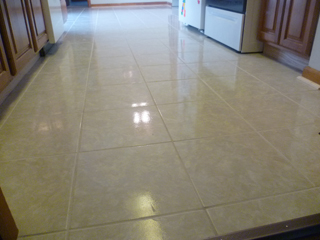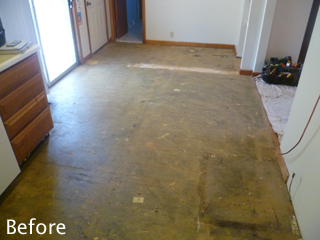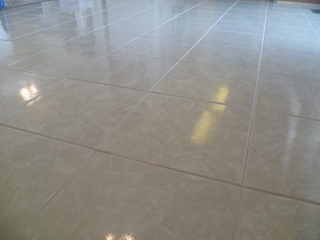 Everyone is different and there’s a tile for every taste. Some people want exotic stone or interesting patterns with decorative elements thrown in. These are a blast, but it’s also fun to keep it simple sometimes. For this tile floor in Spencer, Indiana, (just outside of Bloomington) the homeowners weren’t wanting anything fancy or extravagant. Honestly, I think they were just thrilled to have the carpet out of the kitchen!
Everyone is different and there’s a tile for every taste. Some people want exotic stone or interesting patterns with decorative elements thrown in. These are a blast, but it’s also fun to keep it simple sometimes. For this tile floor in Spencer, Indiana, (just outside of Bloomington) the homeowners weren’t wanting anything fancy or extravagant. Honestly, I think they were just thrilled to have the carpet out of the kitchen!
It’s not unusual for me to get a call after a family has started a project on their own and they are ready for me to finish it up for them. These clients had gotten fed up with the old carpet in the kitchen with residues from a previous owners pets. They decided to go for it and just rip it out themselves.
 Below the carpet was a plywood subfloor. Over the top I installed a layer of Ditra uncoupling membrane in a bed of mortar. This does the job of cementboard in many installations by allowing the plywood subfloor to expand and contract without affecting the tile above. It’s also very thin at only 1/8″ thick. This means the tile floor is kept as low as possible, which is often important with a remodeling project.
Below the carpet was a plywood subfloor. Over the top I installed a layer of Ditra uncoupling membrane in a bed of mortar. This does the job of cementboard in many installations by allowing the plywood subfloor to expand and contract without affecting the tile above. It’s also very thin at only 1/8″ thick. This means the tile floor is kept as low as possible, which is often important with a remodeling project.
 The tiles were just basic 12″ greyish-white ceramic and were thinner than many of the heftier tiles. I made sure to get close to 100 percent mortar coverage under the tiles by ‘back-buttering’ each one. This is an extra step and it certainly adds time and mortar, however, it’s very imporant (especially with thinner or more fragile tiles) to make sure every part of the tile is supported below with plenty of thinset mortar. A void or cavity is a weak spot and a break waiting to happen. I typically ‘back-butter’ all floor tiles that are at least 8″ or larger.
The tiles were just basic 12″ greyish-white ceramic and were thinner than many of the heftier tiles. I made sure to get close to 100 percent mortar coverage under the tiles by ‘back-buttering’ each one. This is an extra step and it certainly adds time and mortar, however, it’s very imporant (especially with thinner or more fragile tiles) to make sure every part of the tile is supported below with plenty of thinset mortar. A void or cavity is a weak spot and a break waiting to happen. I typically ‘back-butter’ all floor tiles that are at least 8″ or larger.
It’s a beautiful improvement to the entire room, and it sounds like it will spark some other improvements like new paint to finish things off.









